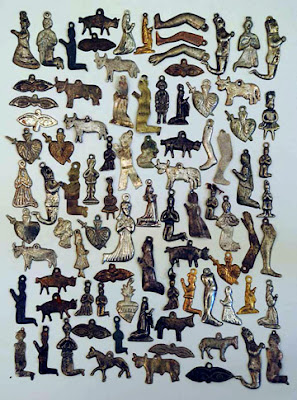It's Leap Year Day and Giachino Rossini's 220th birthday (no, that doesn't mean he would really be 880 years old), so it seemed like a perfect opportunity to try some musical composition.
My musician and composer friends are probably going to be aghast at this little experiment, but it's something I've wanted to try for a long time.
Not that I'm any kind of composer or musician—in fact, the very idea is laughable. In elementary school, I played the violin, once actually causing my private tutor Mr. Hursti to weep in despair. In middle school, I played the clarinet in a school band that should have provided poor Mr. Smith with noise-cancelling headphones instead of a baton. By the time I hit high school, my parents had wisely decided that I was the least musical of their children, and there were no more music lessons for me.
I vaguely remember how to read sheet music, but I've never composed anything before. I'm pretty sure I'm not composing anything today, either, but at least it looks like a piece of music.
My big idea for today's elephant was to place notes in an elephant shape on a piece of stave paper, then play it through a music program on my computer.
I decided to use simple quarter notes, and a single piano as the instrument. Putting any other kind of instrument on here would be far beyond my meagre powers: not only do I not know the software, but I tend to hear only one instrument at a time in my head. Also, if I were composing this in real life, it would likely be produced on a plinky red kiddie piano like Schroeder plays in the Peanuts comic strip.
 |
| Schroeder from the Peanuts comic strip by Charles M. Schulz Source: http://peanuts.wikia.com/wiki/Schroeder |
The first thing I did was get some composition and notation software. I chose a free download from Musescore.org which seemed to have all the features I needed.
Once I had an idea of how the software worked, I laid in a general elephant outline in quarter notes. Sometimes this gave me some nice harmonies, and other times it made me cringe. I adjusted what I could, and left what I couldn't, so there are still some brief moments of horridness—in a 34-second song, perhaps not brief enough. When I tried to put in some eighth-notes and so forth, it only made me mental and looked weird, so quarter notes and a single piano is what you get.
I did adjust a few elements in the design to avoid longish rests and single notes with no harmony or chord, but I didn't go crazy.
This is what the final sheet music looked like—feel free to laugh your heads off. To be honest, I don't even know if it's readable to a real musician. Only my computer knows for sure.
And this is what it sounds like. This blogging platform doesn't seem to support music files, so I whipped this off in iMovie. I only spent about five minutes on the video, so it's nothing special.
It was a ridiculous experiment on a day that shouldn't exist, but I was really curious about what something like this would sound like. It has moments that I like, and moments that make my teeth hurt. But it was fun and took less than an hour. More to the point, the sight of elephant-shaped music made me laugh, which is always the most important thing.
Happy birthday, Mr. Rossini. You must be turning over in your grave.
 |
| Greeting card from Zazzle.com. Source: http://www.zazzle.ca/funny_elephants_playing_music_ birthday_card-137730508120914387 |
Elephant Lore of the Day
For centuries, people familiar with pachyderms have noted elephants' ability to distinguish melodies—a skill that has long been used with circus elephants. In most cases, the music cues portions of the elephant's performance; however, several circuses in the middle of the nineteenth century also featured "elephant bands", which one historian suggests probably sounded "like a herd of angry Buicks".
In 1957, German scientist Bernard Rensch reported in Scientific American that his test elephant could distinguish twelve musical tones, and could remember simple melodies, even when they were played at different pitches, timbres and meters, and on different instruments. Even more astonishingly, the elephant still remembered the tunes eighteen months later.
Elephants have much keener hearing than sight, and use a vast range of vocalizations when communicating—many of which are beyond human hearing. Interestingly, they also appear to have a sense of rhythm and repetition, and even dissonance.
In 2000, Richard Lair, who had worked with elephants for more than two decades, and neurologist David Sulzer (who composes and produces as Dave Soldier), launched the Thai Elephant Orchestra. Gathering six young elephants at the Thai Elephant Conservation Center, the two men showed the elephants how to make sounds on some elephant-sized traditional instruments. These included a gong, drums, a bass, xylophones, a thundersheet and harmonicas.
| Pratida is considered one of the more musically inclined elephants in the Thai Elephant Orchestra. Here she plays the drums. Photo: Millie Young Source: http://www.pathtorhythm.com |
Once they had shown the elephants how to use the instruments, Lair and Sulzer left the elephants to make whatever kind of music they wanted, cueing them only to start and stop. Sulzer was skeptical at first, assuming that the elephants would simply bang about on the instruments, and that the recording would have to be cleaned up in post-production. Instead, to his astonishment, the performances were recorded intact, without overdubbing, and were paused only when outside sounds intruded.
In 2003, the Thai Elephant Orchestra released its first CD on New York-based Mulatta Records. Proceeds from the CD went to a milk bank for orphaned elephants, and a training school for Thai mahouts. To see and hear the Thai Elephant Orchestra in action, click here. And for a video featuring New Age cellist Jami Sieber and her experiences with the Thai Elephant Orchestra's musicians, click here.
To Support Elephant Welfare
World Wildlife Fund
World Society for the Protection of Animals
Elephant sanctuaries (this Wikipedia list allows you to click through to information on a number of sanctuaries around the world)
Performing Animal Welfare Society
Zoocheck
Bring the Elephant Home
African Wildlife Foundation
Elephants Without Borders
Save the Elephants
International Elephant Foundation
Elephant's World (Thailand)
World Wildlife Fund
World Society for the Protection of Animals
Elephant sanctuaries (this Wikipedia list allows you to click through to information on a number of sanctuaries around the world)
Performing Animal Welfare Society
Zoocheck
Bring the Elephant Home
African Wildlife Foundation
Elephants Without Borders
Save the Elephants
International Elephant Foundation

















































